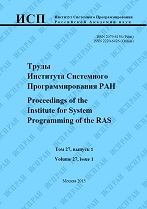|
Using multithreaded processes in ParJava environment
M. S. Akopyan
Institute for System Programming of the Russian Academy of Sciences
Abstract:
Modern processors are based on multicore architectures. Such an approach improves the productivity of processors by decreasing the cost of each processor and increasing its performance. When using multicore processors in nodes of HPC cluster we could use following approaches utilizing node resources: (1) multiprocess program (nx1 — running n processes on a node using one thread in each process); or (2) multiprocess-multithreaded (MPMT) (1xn — running one process on a node and inside of a process n threads may work sharing program data of the process). When using multiple threads in a process inside each process privatization is usually performed to reduce critical sections. In this article we consider the second approach, which will bring better results for parallel application presented in this article because of lack of critical sections. The API and appropriate library has been developed and implemented for MPMT applications. The library allows developing parallel applications using MPI interface and inside of each process it is possible to run a few threads. The parallel MPMT application of FT (Fast Fourier Transformation) on Java has been developed. The comparison of multiprocess version of FT to MPMT version of FT has been made. Tests on implemented application show 9,5–20% performance improvement. The profiling of developed application shows the bottleneck of MPMT FT is mostly in communication scheme between nodes. Improving the communication scheme will bring better results.
Keywords:
parallel computing, parallel SPMD programs using MPI, multi-core, multithreaded Java programs, multiple process-multithreaded programs.
Citation:
M. S. Akopyan, “Using multithreaded processes in ParJava environment”, Proceedings of ISP RAS, 27:2 (2015), 5–22
Linking options:
https://www.mathnet.ru/eng/tisp119 https://www.mathnet.ru/eng/tisp/v27/i2/p5
|

| Statistics & downloads: |
| Abstract page: | 152 | | Full-text PDF : | 86 | | References: | 35 |
|




 Contact us:
Contact us: Terms of Use
Terms of Use
 Registration to the website
Registration to the website Logotypes
Logotypes







 Citation in format
Citation in format 